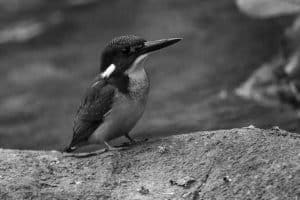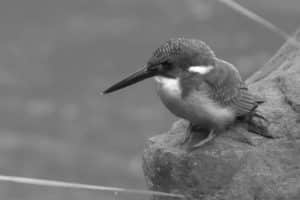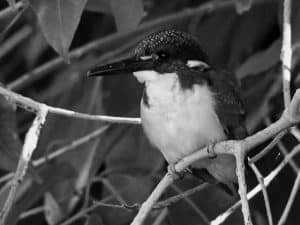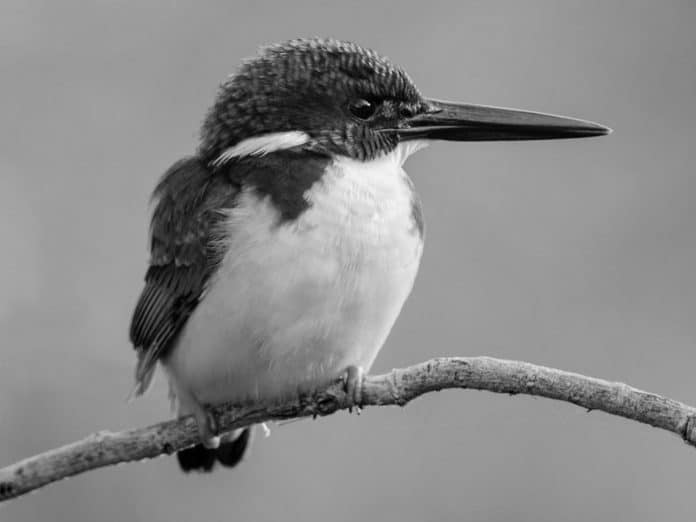Introduction to the Half-Collared Kingfisher
Welcome to the enchanting world of the Half-Collared Kingfisher, a stunning bird species that graces the waterways of Tanzania with its vibrant plumage and graceful presence. The Half-Collared Kingfisher in Tanzania, scientifically known as Alcedo semitorquata, is a member of the kingfisher family and is renowned for its striking appearance and remarkable hunting skills. Found in various water habitats across Tanzania, this beautiful bird has captured the hearts of birdwatchers, photographers, and nature enthusiasts alike.

The Half-Collared Kingfisher is a small to medium-sized bird, measuring around 16 to 17 centimeters in length. Its most distinctive feature is the half-collar of bright blue feathers that adorns its otherwise white throat, creating a captivating contrast against its chestnut-colored belly and vivid blue wings. The male and female Half-Collared Kingfishers display similar plumage, making it a delightful challenge for birdwatchers to differentiate between the two during their observations.
Habitat of the Half-Collared Kingfisher in Tanzania
The Half-Collared Kingfisher is predominantly found in the lush, verdant landscapes of Tanzania, where it seeks out a variety of water habitats to call home. From the tranquil shores of lakes and ponds to the meandering streams and rivers that wind through the country’s diverse ecosystems, these splendid birds can be spotted in a range of watery environments. The presence of overhanging branches, reeds, and other vegetation near the water is particularly appealing to the Half-Collared Kingfisher, providing both shelter and vantage points for their hunting endeavors.
In Tanzania, the Half-Collared Kingfisher can be found in both coastal and inland regions, adding to the allure of its sightings for bird enthusiasts exploring the country’s natural wonders. Whether you venture into the coastal mangroves, the freshwater wetlands, or the tranquil oases nestled within the savannah, there’s a chance to encounter the Half-Collared Kingfisher and witness its captivating behaviors in various aquatic settings.
Behaviors and Characteristics of the Half-Collared Kingfisher
Observing the Half-Collared Kingfisher in its natural habitat offers a fascinating glimpse into the bird’s behaviors and characteristics. As proficient hunters, these kingfishers are known for their remarkable diving abilities, plunging into the water with astonishing precision to catch their aquatic prey. Their keen eyesight and swift reflexes make them adept at capturing small fish, aquatic insects, and even tadpoles, showcasing their prowess as skilled predators.
The distinctive call of the Half-Collared Kingfisher, a series of high-pitched, sharp whistles, often serves as a telltale sign of their presence near water bodies. Their vocalizations, combined with their vibrant plumage, make these birds a delight to both see and hear, further enhancing the allure of encountering them in the wild. Additionally, their agile flight patterns and graceful movements along the water’s edge contribute to the captivating spectacle of observing these avian gems in their natural environment.
Conservation Status of the Half-Collared Kingfisher in Tanzania
The conservation status of the Half-Collared Kingfisher in Tanzania is of paramount importance, given the threats posed to its natural habitats and the delicate balance of the ecosystems it inhabits. As with many species of wildlife, the Half-Collared Kingfisher faces challenges stemming from habitat loss, pollution, and disturbances to its aquatic environments. Efforts to mitigate these threats and safeguard the habitats that sustain these magnificent birds are crucial for their long-term survival.
While the Half-Collared Kingfisher is not currently listed as globally threatened, localized conservation efforts are essential to ensure the well-being of the populations within Tanzania. By addressing the factors that impact their habitats, such as deforestation, water pollution, and human encroachment, conservation initiatives aim to create sustainable environments where the Half-Collared Kingfisher and other wildlife can thrive.
Best Places to Spot the Half-Collared Kingfisher in Tanzania

Tanzania offers a multitude of breathtaking locations where birdwatchers and nature enthusiasts can seek out the captivating sight of the Half-Collared Kingfisher in its natural habitat. The country’s diverse landscapes provide a rich tapestry of potential sightings, each with its own unique allure and opportunities for observing these splendid birds. Whether you’re exploring the coastal regions, the inland waterways, or the verdant wetlands, there are several prime locations renowned for their Half-Collared Kingfisher sightings.
One such notable area is the Rufiji River, a majestic watercourse that winds its way through the Selous Game Reserve in southern Tanzania. Here, the Half-Collared Kingfisher can be observed perched on overhanging branches, scanning the river for potential prey and providing mesmerizing displays of its hunting prowess. The tranquil shores of Lake Manyara, nestled at the base of the Great Rift Valley, also offer a picturesque setting for encountering these striking birds, as they flit and dart along the water’s edge in search of sustenance.
Photography Tips for Capturing the Half-Collared Kingfisher
Capturing the exquisite beauty and captivating behaviors of the Half-Collared Kingfisher through photography is a rewarding pursuit for enthusiasts seeking to document the natural wonders of Tanzania. Whether you’re an experienced wildlife photographer or a novice armed with a camera, there are several strategies and techniques that can enhance your chances of obtaining stunning images of these remarkable birds in their habitat. Understanding the behaviors and habitats of the Half-Collared Kingfisher is pivotal in preparing for successful photography sessions.
Patience is a virtue when photographing the Half-Collared Kingfisher, as these birds may exhibit elusive behaviors and swift movements along the water’s edge. By observing their routines and preferred perches, you can anticipate their actions and position yourself for optimal vantage points. Utilizing long lenses with fast autofocus capabilities can aid in capturing the intricate details of the Half-Collared Kingfisher’s plumage and expressions, allowing for compelling portrayals of their beauty and grace.
Ecotourism and the Half-Collared Kingfisher
Ecotourism plays a significant role in promoting the conservation of the Half-Collared Kingfisher and its natural habitats in Tanzania. By fostering sustainable travel practices that prioritize the well-being of wildlife and the environment, ecotourism initiatives offer opportunities for visitors to engage with the country’s diverse ecosystems while supporting conservation efforts. The allure of encountering the Half-Collared Kingfisher in the wild serves as a powerful incentive for ecotourism activities that promote responsible and ethical interactions with these captivating birds.
Engaging in birdwatching excursions, guided nature walks, and wildlife photography tours allows visitors to appreciate the splendor of the Half-Collared Kingfisher while contributing to the local economies and conservation programs. Furthermore, ecotourism endeavors often raise awareness about the importance of preserving the habitats that sustain these avian treasures, inspiring visitors to become advocates for the protection of Tanzania’s natural heritage.
The Importance of Preserving the Half-Collared Kingfisher’s Habitat
Preserving the habitats of the Half-Collared Kingfisher is essential for safeguarding the well-being of this remarkable species and the myriad of other organisms that depend on these ecosystems. The interconnectedness of aquatic environments, riparian zones, and surrounding landscapes underscores the significance of maintaining the ecological balance necessary for the Half-Collared Kingfisher’s survival. Wetlands, rivers, and lakes serve as vital lifelines for these birds, providing nourishment, shelter, and breeding grounds crucial for their continued presence in Tanzania.
Conservation efforts aimed at preserving the habitats of the Half-Collared Kingfisher encompass a range of strategies, including habitat restoration, water quality management, and the establishment of protected areas. Collaborative initiatives involving local communities, governmental agencies, and conservation organizations play a pivotal role in addressing the challenges posed by habitat degradation and anthropogenic pressures. By recognizing the intrinsic value of these habitats and the biodiversity they support, concerted endeavors strive to ensure the enduring presence of the Half-Collared Kingfisher and the preservation of Tanzania’s natural splendor.
Local Efforts and Organizations for Half-Collared Kingfisher Conservation

Local efforts and organizations dedicated to Half-Collared Kingfisher conservation in Tanzania are instrumental in implementing initiatives that safeguard the well-being of these captivating birds and their habitats. Through community engagement, research endeavors, and advocacy campaigns, these entities play a vital role in addressing the conservation challenges faced by the Half-Collared Kingfisher and other wildlife species. By fostering collaborations and empowering local stakeholders, these organizations strive to effect positive change for the benefit of Tanzania’s natural heritage.
Conservation organizations such as the Tanzania Bird Atlas and the Wildlife Conservation Society of Tanzania work tirelessly to monitor bird populations, conduct research on habitat dynamics, and raise awareness about the importance of preserving the ecosystems that support the Half-Collared Kingfisher. These organizations also play a crucial role in educating local communities, fostering stewardship of natural resources, and advocating for policies that promote sustainable conservation practices. By nurturing a sense of shared responsibility for the welfare of the Half-Collared Kingfisher and its habitats, these organizations contribute to the long-term protection of Tanzania’s avian treasures.
Conclusion
In conclusion, the Half-Collared Kingfisher stands as a jewel by the water’s edge, captivating all who have the privilege of witnessing its vibrant plumage and enchanting behaviors in the natural splendor of Tanzania. As guardians of its habitats and stewards of its conservation, we hold the responsibility of preserving the ecological balance that sustains these remarkable birds and the diverse ecosystems they inhabit. By supporting ecotourism initiatives, advocating for habitat preservation, and engaging with local conservation efforts, we can contribute to the enduring presence of the Half-Collared Kingfisher, ensuring that future generations may continue to marvel at its iridescent beauty amidst the landscapes of Tanzania.

































